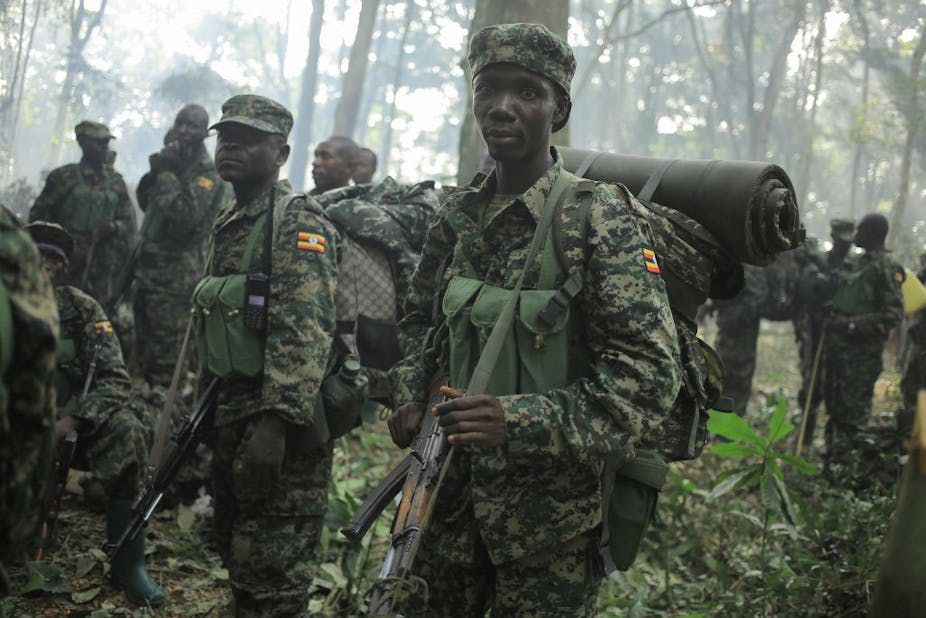
Ugandan soldiers in the deep forests of eastern Democratic Republic of Congo in 2021. Alain Uaykani/Xinhua via Getty Images
The Islamic State Central Africa Province recently attacked and killed two foreign tourists and a citizen in a Ugandan nature park. Located in the country’s west near the border with the Democratic Republic of Congo (DRC), Queen Elizabeth National Park is about 400km from the Ugandan capital Kampala.
The attack was aimed at Uganda’s most important source of foreign currency, the tourism sector. The sector generated 7.7% of Uganda’s gross national product before a slump linked to the Covid pandemic.
The attack highlights a departure from previous attacks by the armed group towards new targets: western tourists in Uganda. It also highlights how regional rivalries in the border areas of Congo-Uganda-Rwanda function as oxygen that has enabled the organisation to survive and grow.
The evolution
The group, originally known as the Allied Democratic Forces (ADF), was formed and financed by the rulers of the DRC (then Zaire) Mobutu Sese Seko, and Sudan Omar al Bashir to launch insurgent attacks on their common enemy in the mid-1990s – Uganda. The ADF was thus initially used by Mobutu and Bashir as a weapon in regional rivalries to check Yoweri Museveni’s influence.
At the time of its formation in 1995, ADF was a rather weird merger of two vastly different organisations.
The first consisted of former members of the National Army for the Liberation of Uganda that had been based around the mainly Christian Bakonjo-Baamba people of the Rwenzori region in western Uganda, and near the border with DRC.
The second part of the organisation consisted of fighters from the Ugandan Islamic Salafi Foundation, an organisation with roots going back to protests against Uganda’s attempts to control its Muslim congregations in the early 1990s.
Uganda forced the new group into the eastern provinces of Congo where it was supported by the Mobutu regime before its overthrow in 1997. It survived the fall of Mobutu by withdrawing deep into the forests and mountains in the border areas between Uganda and Congo.
Over time, ADF grew more Islamic, partly due to Ugandan amnesties that convinced several of the more moderate leaders of the ADF to defect. Signs of a more radical organisation emerging could be seen from 2011. The Islamic State accepted the organisation as a province in 2019. When the ADF leader swore allegiance to the Islamic State, there were some defections from the few remaining commanders who had National Army roots.
Change in strategy
Since 2021, the Islamic State Central Africa Province has launched two different types of attacks against Uganda. First, terror attacks and assassinations far from the Congolese border in places like Kampala. Second, heavy, more military-style attacks against civilians in Uganda’s border with the DRC.
It’s increasingly using more traditional terror tools and has introduced new propaganda material, such as videos with beheadings. Suicide bombings have also become part of its repertoire. The group even attempted to assassinate Ugandan government leaders.
From 2022, the group has carried out heavier raids into Uganda, including attacking a school in June 2023 in a town near the Uganda-Congolese border. It has also launched several attacks against businesses in the border zone.
Uganda’s response
The increase in the Islamic State Central Africa Province attacks led to a Congolese-approved Ugandan intervention in Congo that began in December 2021. The rebel group initially withdrew into the deep forests of the Rwenzori mountains and the Ituri rainforest in the north-eastern parts of Congo. These are close to the DRC’s Virunga National Park, another large area of wilderness and mountains that’s perfect to hide in.
This renewed pressure might have led parts of the rebel group into Ugandan territory in the Rwenzori Mountains National Park. This isn’t too far from Queen Elizabeth National Park where the recent terror attacks occurred.
This latest intervention continues a pattern of Ugandan and Congolese offensives that lead to temporary withdrawals of the rebel group into the forest and mountains around the Uganda-Congo border. These offensives usually end with the rebels returning into towns and cities upon Ugandan and Congolese withdrawals.
Importantly, the current offensive has failed to end terror attacks inside Uganda.
Adding to the complexity of the intervention are ongoing attacks from the largest guerilla group in eastern Congo, the March 23 Movement (M23). M23 has had recent success on the battlefield, recapturing towns from government forces.
The M23 offensive takes place to the south and west of the area where the Islamic State in Central Africa Province is operating, but has repercussions for the group. First, the recent round of warfare in eastern DRC has created a record 6.9 million refugees due to escalating violence, creating chaos that the group can take advantage of.
Second, the ongoing fighting has drawn the Congolese army away from its campaign against the Islamic State in Central Africa Province, and hinders Congolese-Rwandese cooperation against it. This is due to Rwandan support for the M23, which Kigali officially denies providing.
The way forward
The Islamic State in Central Africa Province thrives on Congolese-Rwandese rivalry, as well as regional mistrust dating back decades. Creating real regional cooperation and trust would be the first step toward ensuring that the Islamic State’s local outfit is stopped. It would also help address nearly three decades of fighting in the Congo.
For this to happen, however, African – as well as other international actors – need to stay focused on the conflict in Congo and the unrest in the Uganda-Rwanda-DRC border areas. It’s also important to actively strive for dialogue, especially between Rwanda and Congo.![]()
Stig Jarle Hansen, Associate Professor of International Relations, Norwegian University of Life Sciences
This article is republished from The Conversation under a Creative Commons license. Read the original article.

